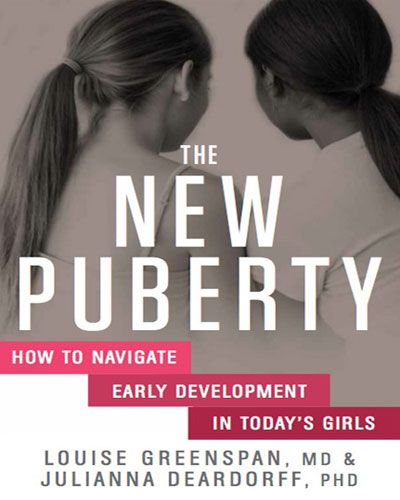The New Puberty by Louise Greenspan, MD and Julianna Deardorff, PhD

Summary
Authors Louise Greenspan, MD and Julianna Deardorff, PhD are researchers and practitioners that specialize in pubertal development and adolescent health. In this book, they detail the challenges associated with girls hitting puberty early and discuss how early development can be a risk factor for breast cancer later on. They also bring up the concerns around environmental exposure, because “puberty does not occur in a vacuum.” Lifestyle choices, chemicals, nutrition, exercise, and more can impact how young girls mature. While this book was initially released in 2014, it remains a cornerstone of the discussion of risk reduction in modern youth and ways we can empower ourselves to live healthy lifestyles.
Sections in the book
The chapters in this book fall into two categories, including “The Causes of Early Puberty” and “Strategies to Help Growing Girls Thrive.” Each section discusses the science behind puberty and ways adults can help reduce the risks associated with early development.
“The Causes of Early Puberty”
In the beginning of the section, the authors define puberty, how it begins, the process it follows, and what factors may accelerate it. For example, they clearly detail three forces in particular including excess fat, exposure to chemicals that disrupt healthy biology, and social and psychological stressors. Also, they reveal the fact that while different communities and populations appear to have a higher incidence of early puberty, it is likely the result of environmental issues rather than genetics.
This generation of girls is experiencing many different societal pressures that impact their health, and early puberty can be a risk factor for a variety of behavioral health risks including body-image issues, substance abuse, poor academic performance, depression, and anxiety. In addition to these risks, there are many physical health concerns including the fact that “girls who get their periods early have up to a 30 percent increased risk of breast cancer as adults.” However, the authors are very optimistic and provide many clear ways parents (and other caring adults) can mitigate these odds by providing a nurturing environment. There is still a lot of work adults can do to support the youth in their lives, and this section gives a great insight as to what young girls are facing in modern times and ways to protect their health. For example, teaching girls at a young age to develop healthy habits like exercising regularly and eating well can reduce their risk of developing health problems later in life. Also, encouraging them to get enough sleep, limit their exposure to harmful chemicals, and ultimately creating loving and supportive home can be great ways to change the face of early puberty.
“Strategies to Help Growing Girls Thrive”
In response to the increased health risks associated with the next generation, the second section takes particular aim as to how we can work together to provide a better future for today’s girls. After providing more detailed information on the science of puberty, they give hands-on tips about seeking medical assistance and how to discuss treatment options with your provider. They also give specific ways you can be a smart consumer and avoid harmful chemicals in everything from food, beauty products, household items and more. Combined with a detailed guide to creating healthy lifestyle habits, this section tackles everything from nutrition, sleep, exercise, and more. You can also gain insight as to how to apply these tips with your children as you create a sustainable and healthy home.
Conclusions
This book is a great resource for adults working with young girls, and provides many myth-busting facts that are grounded in science and research. For example, the authors often go back to the idea that puberty is not simply a door you walk through, but rather a hallway that has many different stages. Ultimately the authors are very optimistic that we can address the challenges of this new puberty so long as we work to create systems and environments that support both the mental and physical wellbeing of our youth. Grounded in science and informed by practical real world approaches this book is a valuable resource!
This book is 272 pages.
To learn more about the book and the authors check out Dr. Greenspan's TED Talk here, and to order your own copy click
Book review by ZBC Program Manager Cailen Wright. View a Spanish-language translation of this book review here.

